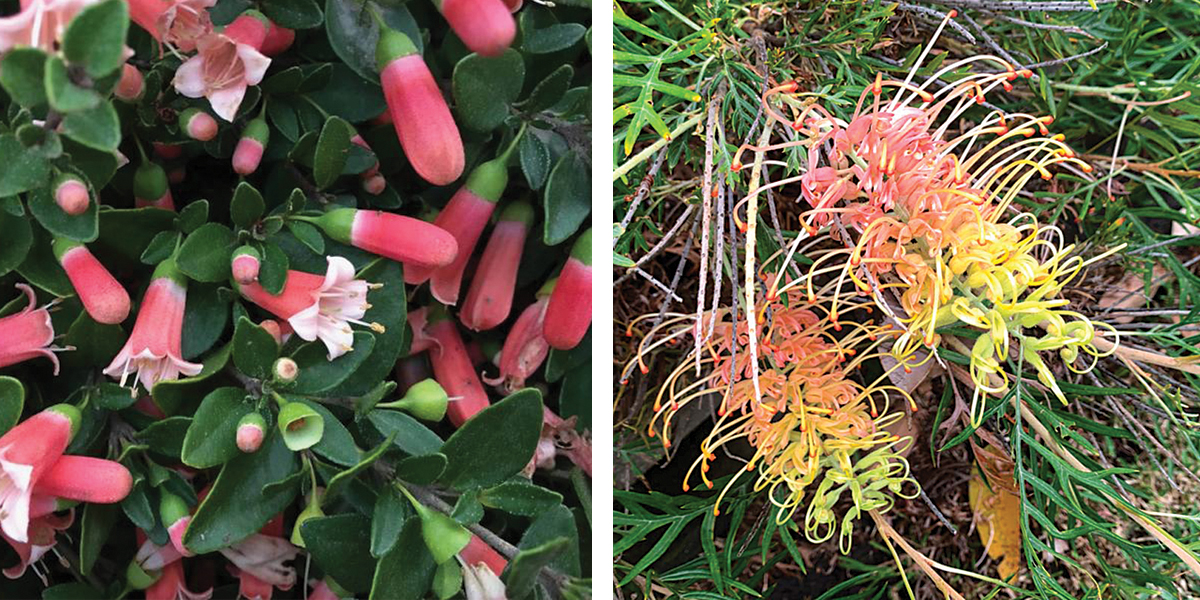Shrubs from Down Under can brighten a winter garden

 CONTRA COSTA COUNTY, CA (Oct. 13, 2021) — If you want more blooms in your autumn landscape, look no farther than Australian plants.
CONTRA COSTA COUNTY, CA (Oct. 13, 2021) — If you want more blooms in your autumn landscape, look no farther than Australian plants.
Our fall is Australia’s spring. So, as many of our plants change color for their winter break, shrubs from Down Under are getting ready to bloom.
Australian plants are very adaptable to our climate. They thrive in our heat, are very drought-tolerant, take little to no fertilizer and can deal with our soil challenges. Autumn is the perfect time to introduce Australian plants to your landscape.
Several super-hardy, evergreen bushes with long flower displays come by way of Australia. Correa, Grevillea, Callistemon and Westringia are all tough as nails and worthy of any local landscape.
Slopes and banks
Correa has the common name of Australian fuchsia because the flower’s shape resembles the coastal fuchsia we all know. Correa is a dense evergreen that can reach 3 feet tall and eventually 6 feet wide. This shrub is great on slopes and banks as the flowers can be appreciated more when looking up into the plant. Correa blooms from fall through late spring. Plant in mostly sun. It will need little summer water once established.
Grevillea is a large family of highly attractive, evergreen shrubs and ground covers. Peaches and Cream has brocade-shaped leaves that create a weeping, rounded shape to it growth. Expect it to reach 5 feet tall and equally as wide. Give this beauty room to mature because this type of shrub looks best when it is allowed to grow naturally. Fragrant peach and cream flowers appear in early winter and continue through early summer. This shrub looks best on a hillside, along a fence line or used to create a property line. Hummingbirds are extremely attracted to Grevillea Peaches and Cream.
Callistemon is better known as a bottlebrush bush. The bottlebrush of the ’70s has been replaced by Little John Callistemon, a very desirable dwarf. Little John grows naturally rounded, reaching 3 feet tall and wide. The gray-green leaves appear to spiral off the stems, giving the foliage a unique patterning. During the middle of winter through late spring, intense crimson, bottlebrush-shaped flowers are sprinkled along stem ends. The flowers of Little John are both bee- and hummingbird-friendly. Install this evergreen as a foundation planting in a mixed garden bed or along narrow strips since it can be easily shaped. Little John can tolerate heat, clay soil and drought.
Fabulous Westringia
Westringia fruticosa is fabulous. This evergreen shrub has hazy, gray foliage and tiny periwinkle flowers from autumn through spring. Westringia has a freeing growth style that can reach 5-6 feet tall and wide. Like many Australian shrubs, install this where it has room to mature. Westringia looks awful when folks try to control the growth. Plant it along a fence line, where its foliage can contrast off the wood.
Anigozanthos, aka Kangaroo Paw, is the most popular Australian plant. Grass-like foliage acts as a base for tall stalks of red, orange, yellow or sometime pink flowers. The common name comes from the description of the flower bud once it’s open, when it looks like the bottom of a kangaroo’s paw. This plant does have a moderate failure rate due to summer overwatering. Foliage tends to brown, so consider installing behind a boulder.
There are many drought-tolerant plants to consider to make your landscapes unique while being easy to care for and beautiful.

Nicole Hackett
Nicole is the Garden Girl at R&M Pool, Patio, Gifts and Garden. You can contact her with questions or comments by email at gardengirl94517@yahoo.com
